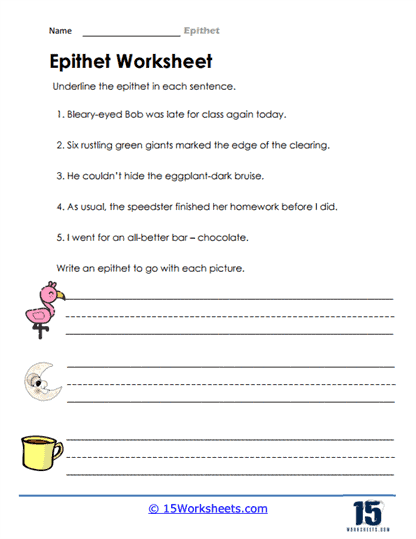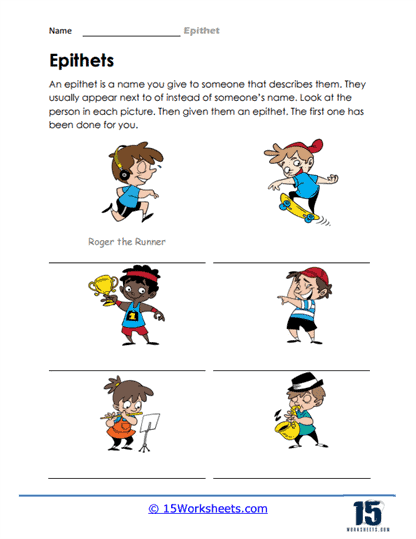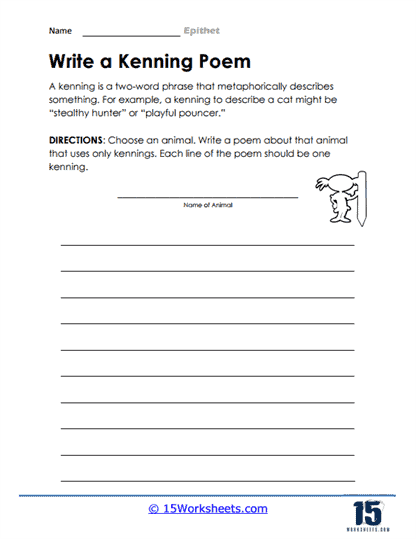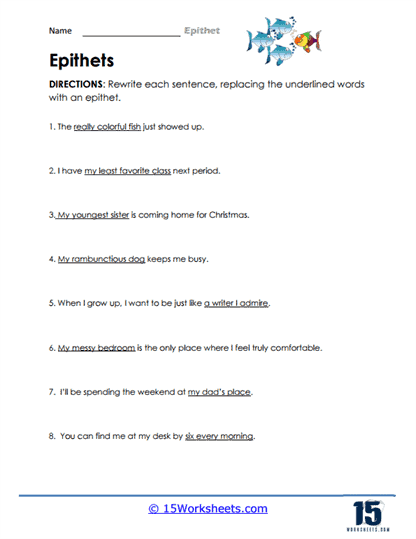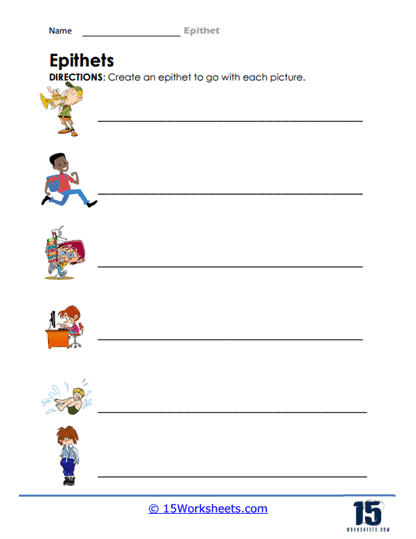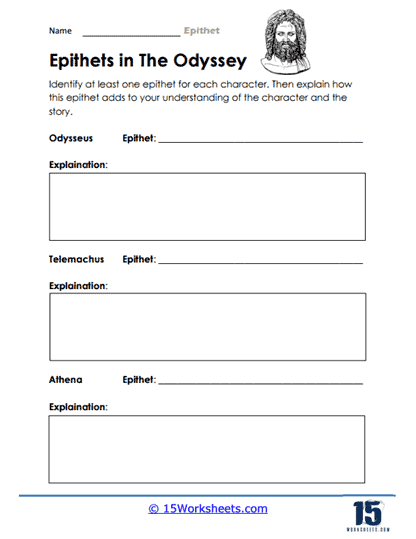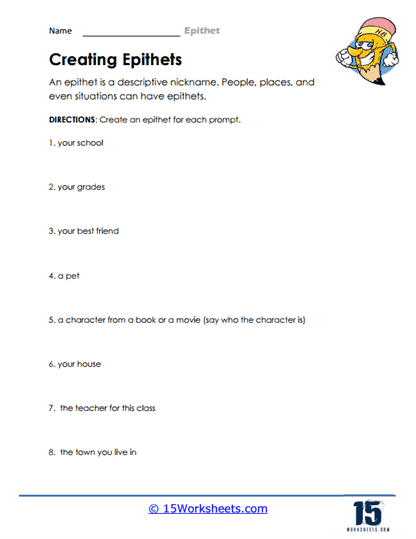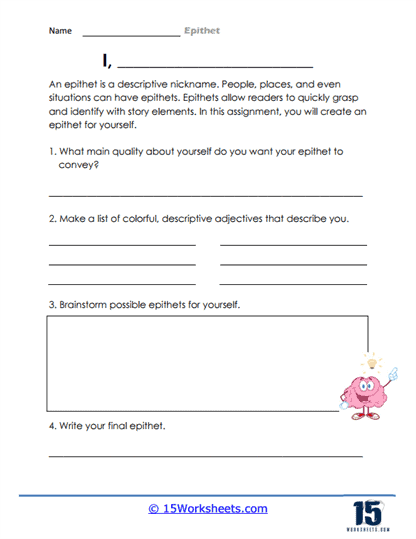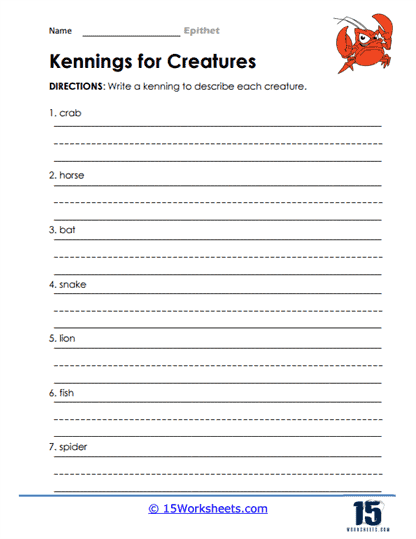Epithet Worksheets
About These 15 Worksheets
Epithet worksheets are educational tools designed to enhance students’ understanding and use of epithets in literature and writing. An epithet is a descriptive phrase or adjective used to characterize a person, place, thing, or idea, often highlighting a particular quality or attribute that is distinctive to the subject. These worksheets aim to develop students’ abilities to recognize, analyze, and creatively employ epithets, thereby enriching their language arts and reading skills.
By engaging with these worksheets, students not only enhance their understanding and use of epithets but also develop a range of skills crucial for literacy and communication. Through identification, analysis, creative writing, and contextual exploration, students improve their vocabulary, analytical thinking, creative expression, and reading comprehension. The practice of working with epithets thus enriches students’ engagement with language and literature, fostering a deeper appreciation for the art of writing and the power of words to convey complex ideas and emotions.
Types of Exercises
Identification Exercises – Students are given passages from literature, speeches, or everyday language and asked to identify the epithets used. This foundational exercise helps students recognize how epithets function to add depth and specificity to descriptions.
Analysis Exercises – After identifying epithets, students analyze their purpose and effect within the text. They might discuss how epithets contribute to character development, setting description, or thematic emphasis. This type of exercise encourages critical thinking about language use and its impact on the reader’s experience.
Comparison Exercises – These exercises involve comparing epithets used to describe similar subjects in different texts or by different authors. Students evaluate how varying epithets alter the perception of the subject, thereby understanding the power of language in shaping narrative tone and reader interpretation.
Creative Writing Exercises – Students apply their understanding by writing their own sentences or short passages using epithets. This hands-on approach reinforces their grasp of epithets and encourages creative expression, allowing them to experiment with language to evoke specific images or emotions.
Matching Exercises – Worksheets may include exercises where students match epithets to the correct subjects based on context clues. This activity helps students develop an intuitive sense for how epithets can succinctly capture and convey essential qualities of their subjects.
Transformation Exercises – In these exercises, students are asked to rewrite sentences or passages, replacing epithets with plain descriptions or vice versa. This helps them appreciate the stylistic and emotional difference between straightforward description and the evocative power of epithets.
Contextual Usage Exercises – Students explore how the context of a narrative influences the choice of epithets, understanding that epithets can serve different purposes depending on their narrative or poetic context.
Historical and Cultural Exploration Exercises – These exercises encourage students to research and understand the historical and cultural significance of certain epithets, especially those that recur in classical literature, folklore, or historical texts, enhancing their appreciation for the depth and richness of language.
The Benefits Of These Worksheets
Engaging with epithet worksheets offers numerous benefits to students’ development in language arts and reading skills:
Enhanced Vocabulary and Expression – Through the study and use of epithets, students expand their vocabulary and learn to express complex ideas and descriptions more succinctly and vividly. This skill is invaluable in all forms of writing and oral communication.
Improved Analytical Skills – Analyzing the purpose and effect of epithets in texts enhances students’ analytical abilities, enabling them to discern subtleties in language and how it shapes meaning, tone, and reader experience.
Creative Thinking – Creative writing exercises that incorporate epithets encourage students to think creatively about language and its possibilities, fostering a more expressive and nuanced writing style.
Deeper Understanding of Texts – By examining how epithets contribute to character development, setting, and theme, students gain a deeper understanding of literary texts and the techniques authors use to engage readers.
Appreciation for Literary Devices – Working with epithets helps students appreciate the broader array of literary devices at an author’s disposal, understanding how these devices work in concert to create rich, immersive reading experiences.
Cultural and Historical Awareness – Exploring the historical and cultural contexts of epithets enhances students’ awareness of how language evolves and reflects the values and perceptions of different times and societies.
Enhanced Reading Comprehension – The skills developed through epithet exercises-such as identifying significant details, understanding character traits, and appreciating stylistic nuances-contribute to overall improved reading comprehension and the ability to engage with complex texts.
Critical Thinking and Interpretation – Exercises that require students to interpret the significance of epithets or to consider their effect on the reader foster critical thinking skills. Students learn to question and interpret the author’s choices, leading to a more engaged and thoughtful reading process.
What is the Literary Device of Epithet?
The literary device of epithet plays a pivotal role in the realm of written expression, offering writers a powerful tool to enhance characterization, enrich narratives, and imbue their works with a deeper sense of imagery and emotion. An epithet is a descriptive phrase or adjective that is used to characterize a person, place, thing, or idea, often highlighting a key trait, quality, or attribute that is significant to the subject. This device is not merely decorative; it serves crucial functions in literature, from evoking vivid imagery to providing insight into characters and settings.
Main Defining Feature of an Epithet
The main defining feature of an epithet is its ability to encapsulate and highlight a distinctive quality of its subject in a concise and impactful manner. Unlike general descriptions, an epithet often sticks to a subject throughout a piece of literature, serving as a shorthand for the subject’s character, physical appearance, or other defining traits. It is this repeated association that deepens the reader’s understanding and emotional connection to the subject.
Characteristics of an Epithet
Descriptive Precision – Epithets provide precise descriptions that enhance the reader’s understanding of a character or object. They go beyond mere physical appearance to encapsulate the essence of the subject’s nature or condition.
Economical Use of Language – With brevity and economy, epithets convey complex descriptions and emotions, often in a few words. This succinctness is key to their effectiveness.
Enhanced Imagery – Through vivid and often symbolic language, epithets enhance the imagery of a text, enabling readers to visualize characters and settings more vividly.
Emotional Resonance – Epithets can evoke a strong emotional response, establishing a deeper connection between the subject and the reader by highlighting traits that elicit sympathy, admiration, disdain, or other emotions.
Thematic Reinforcement – Often, the use of epithets is aligned with the broader themes of a work, reinforcing the narrative’s thematic concerns through the repeated invocation of certain qualities or ideas.
Examples of Epithets in Literature
Example 1 – Homer’s “The Iliad” and “The Odyssey”
Homer frequently employs epithets in his epic poems to characterize gods and heroes, making these figures memorable and their qualities vivid to the audience. A famous example is “swift-footed Achilles,” used throughout “The Iliad.” This epithet not only describes Achilles’ physical prowess but also underscores his role as a swift agent of death on the battlefield, highlighting his heroic yet tragic nature. Similarly, Odysseus is often called “wily” or “the man of twists and turns” in “The Odyssey,” emphasizing his cunning intelligence and adaptability, which are crucial to his survival and success.
Example 2 – William Shakespeare’s “Othello”
In “Othello,” Shakespeare uses the epithet “the Moor” to refer to Othello throughout the play. This epithet highlights Othello’s racial and cultural difference from the Venetian society in which he lives and serves. It underscores the themes of otherness, racism, and jealousy that permeate the tragedy. The constant reminder of Othello’s ethnicity through this epithet serves to foreground the societal prejudices and personal insecurities that lead to his tragic downfall.
Example 3 – Charles Dickens’ “A Christmas Carol”
Dickens uses the epithet “Scrooge” as a synonym for miserliness and lack of Christmas spirit, derived from his character Ebenezer Scrooge in “A Christmas Carol.” The transformation of Scrooge from a “squeezing, wrenching, grasping, scraping, clutching, covetous old sinner” to a benevolent figure underscores the themes of redemption, the spirit of Christmas, and the potential for change in human nature. The use of Scrooge’s name as an epithet in everyday language demonstrates the profound impact of Dickens’ characterization and the thematic depth of the narrative.
The Effect of Epithets on the Reader
The use of epithets in literature has a profound effect on readers, shaping their perception, understanding, and emotional engagement with the text:
Enhanced Visualization – Epithets help readers visualize characters and settings more vividly, making the narrative more immersive and engaging.
Deeper Characterization – By encapsulating key traits of characters, epithets contribute to a deeper and more nuanced understanding of their personalities, motivations, and relationships.
Emotional Engagement – The emotional resonance of epithets draws readers more deeply into the narrative, fostering empathy, antipathy, or other emotional responses that enhance the reading experience.
Thematic Resonance – Epithets often echo the themes of a work, reinforcing its central ideas and motifs, and encouraging readers to reflect on its deeper meanings.
Memorability – The repeated use of distinctive epithets makes characters and themes more memorable, aiding in the retention of key aspects of the narrative.






